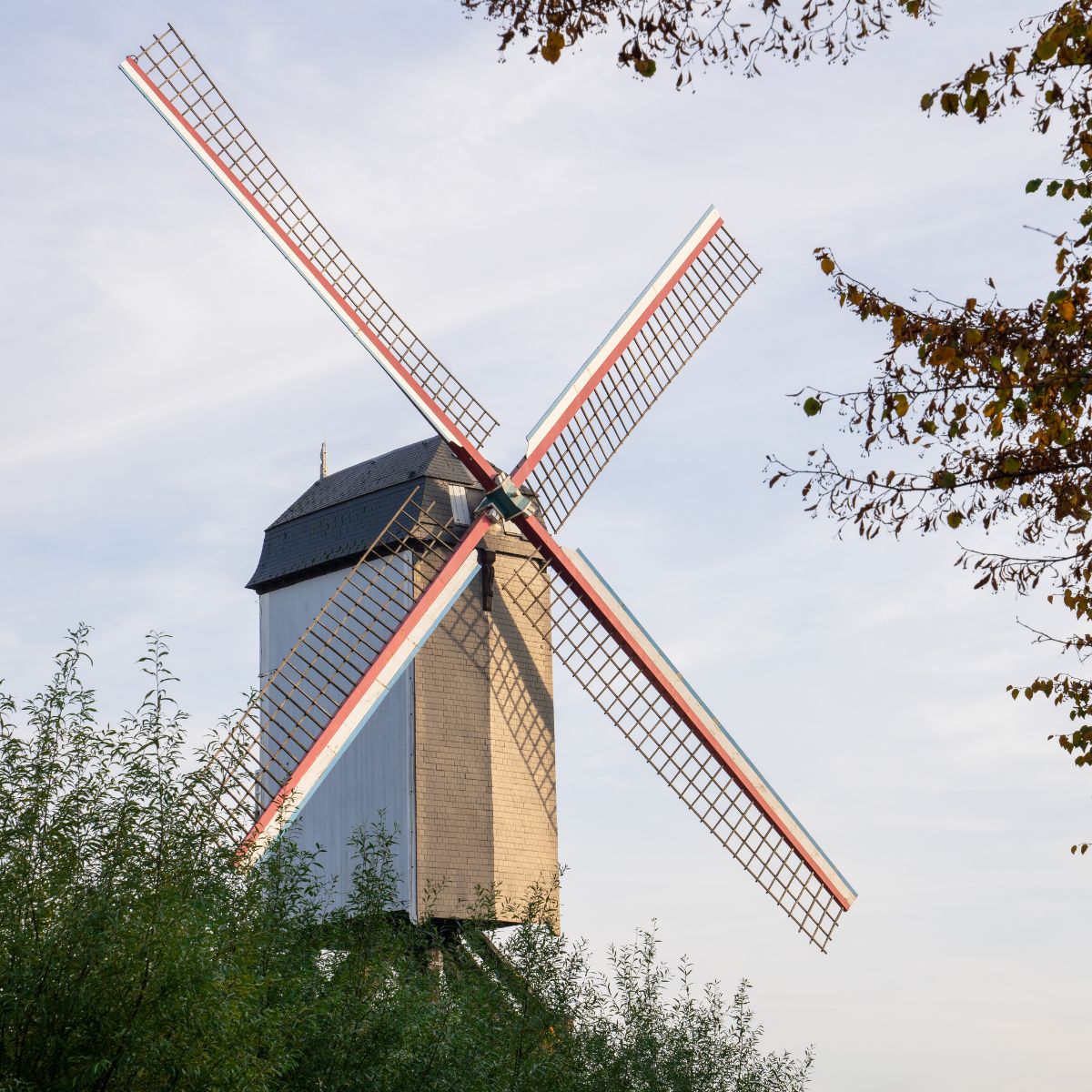Discover the Essential Works Of the Louvre Museum
Planning to visit the Louvre Museum in Paris? You are about to experience one of the most impressive art collections in the world!
The Louvre is known for its vast collection of masterpieces, including paintings, sculptures, art objects and architectural elements from different periods and origins.
In this article, you will discover the essential works of the Louvre that you cannot miss. From Leonardo da Vinci’s famous Mona Lisa to the Victory of Samothrace, a wealth of masterpieces will take your breath away.
Whether you’re an art lover or just a curious tourist, there’s something for everyone at the Louvre.
We will explore some of the museum’s most famous works of art and some lesser-known gems that deserve your attention. Get ready to immerse yourself in the beauty and history of the Louvre.
You may also be interested in visiting The Museums of the 16th Arrondissement of Paris.
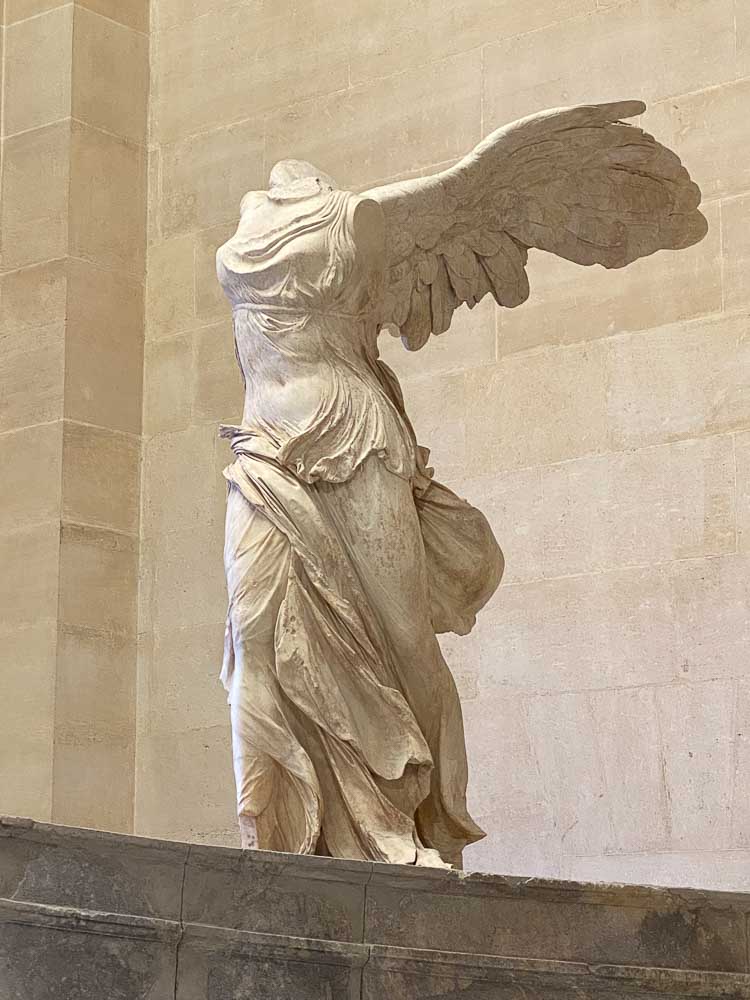
History Of the Louvre Museum
The Louvre Museum is one of the largest and most famous museums in the world. It is located in the heart of Paris and is home to some of the most important and valuable works of art in history.
The building in which the museum is housed has a rich and fascinating history dating back more than 800 years.
Originally, the building that now houses the Louvre Museum was built as a fortress to protect the city of Paris from invaders.
For centuries, the building was used as a royal residence by French monarchs. It was Louis XIV who transformed the building into a public museum in 1793, making it one of the first public museums in the world.
Since then, the Louvre Museum has grown and evolved constantly. Today, the museum has more than 35,000 works of art, ranging from antiquity to the 19th century.
Among the museum’s most famous works are Leonardo da Vinci’s Mona Lisa, the Venus de Milo and the Victory of Samothrace.
Essential Works at the Louvre Museum
If you are planning a visit to the Louvre Museum in Paris, you should know that there are many must-see works that you must see.
The Louvre is one of the largest museums in the world and houses an incredibly extensive collection of works of art. Here are some of the essential works not to be missed:
- The Mona Lisa: perhaps the Louvre’s most famous work, this iconic portrait by Leonardo da Vinci is one of the most recognizable images in the world. She is a unique work of art, and her enigmatic smile has inspired generations of artists.
- The Venus de Milo: this Greek sculpture from the 2nd century BC represents the goddess of love and beauty. It is one of the most famous sculptures in the world, and is a masterpiece of ancient sculpture.
- Liberty Leading the People: this painting by Eugène Delacroix is one of the masterpieces of French Romanticism. It depicts an allegorical figure of liberty leading French citizens during the Revolution of 1830.
- The Victory of Samothrace: this 2nd-century BC Greek sculpture depicts the goddess of victory, and is one of the most impressive works in the Louvre. It was discovered on the island of Samothrace in the 19th century and has since been admired by millions of visitors.
Before starting with this list, you should know that there are many, many more works in the Louvre and this is a totally subjective list that could have gone on much longer, but I didn’t want to bore you.
The best thing to do is to visit the museum, take a look at my favorites and tell me in the comments which Louvre artworks you liked the most.
If you want to visit every museum in Paris, you have to check this post with the top museums in Paris.
The Mona Lisa
If you visit the Louvre Museum, you can’t miss the Mona Lisa, one of the most famous masterpieces in the world. This painting by Leonardo da Vinci is known for its enigmatic smile and innovative technique.
The Mona Lisa is located in the States room on the first floor of the museum.
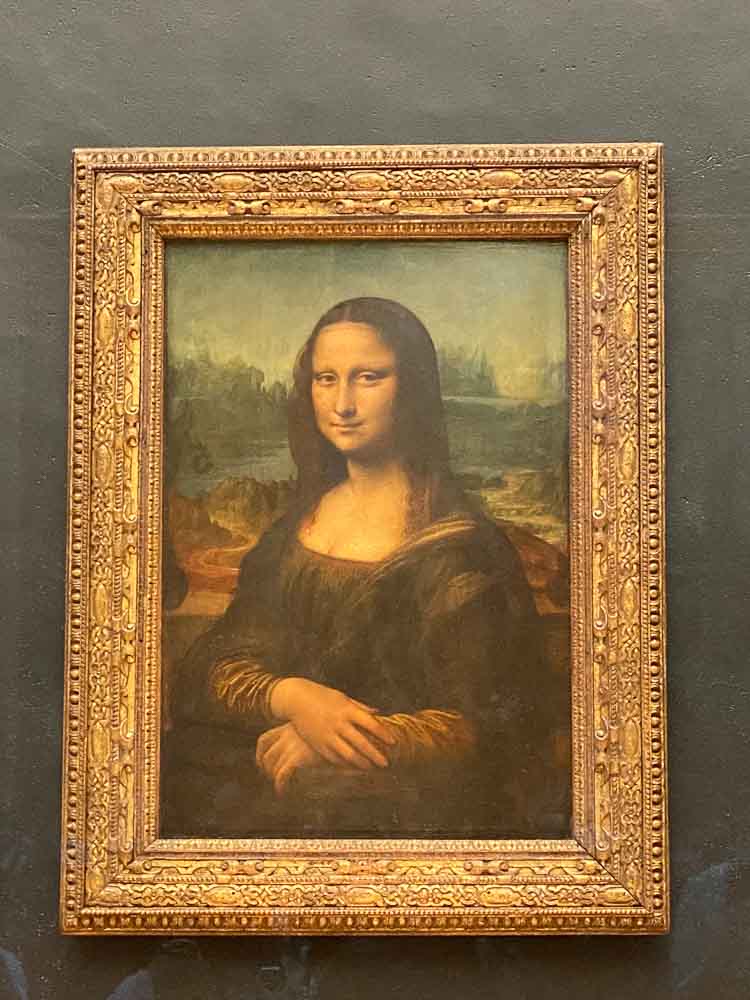
Before reaching the Hall of the States, you must walk a long way through the museum galleries. But once you get there, you’ll see that the Mona Lisa is an impressive work of art.
The painting is located behind a glass box and is protected by security guards.
The Mona Lisa is a small painting, barely 77 x 53 cm, but its value is incalculable. The painting has been subject to numerous thefts and has been vandalized on several occasions, so it is now very well protected.
If you want to take a picture of the Mona Lisa, you will have to do so from a considerable distance, as you are not allowed to get too close to the painting.
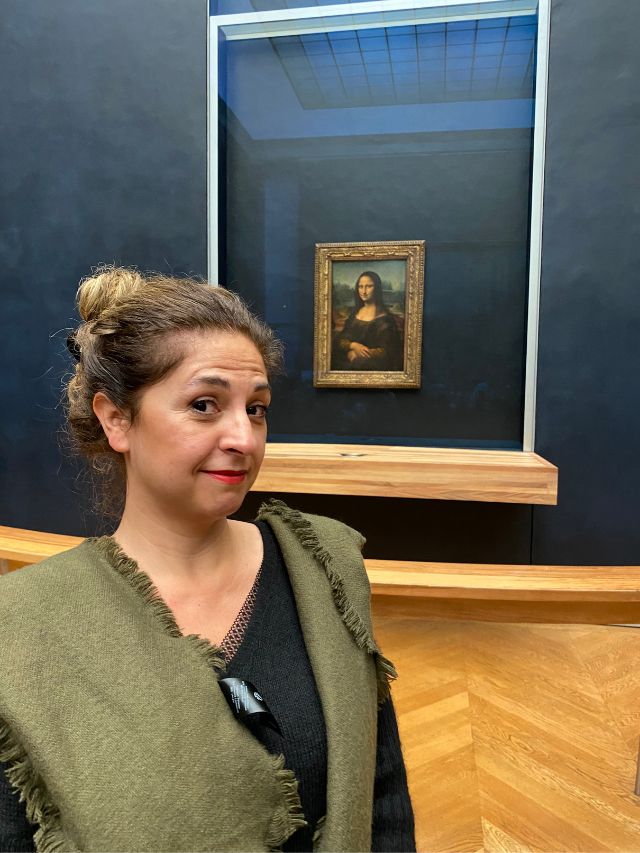
Although the Mona Lisa is one of the world’s most famous masterpieces, there is still much that is unknown about her.
The painting is believed to have been commissioned by Francesco del Giocondo, a wealthy Florentine merchant, for his wife Lisa Gherardini. However, there are many theories and legends about the identity of the woman portrayed in the painting and about the meaning of her enigmatic smile.
The Victory of Samothrace
If there is one masterpiece you can’t miss at the Louvre, it’s The Victory of Samothrace, it’s my favorite. This sculpture is one of the most famous and appreciated in the museum, and is considered one of the best works of art of the Hellenistic period.
The Victory of Samothrace, also known as the Nike of Samothrace, is a marble sculpture depicting the Greek goddess of victory, Nike. The sculpture was discovered on the island of Samothrace in 1863 by Charles Champoiseau and is believed to date from the 2nd century BC.
The Victory of Samothrace is an impressive work that is more than 5 meters high and is located on a staircase in the Daru wing of the museum.
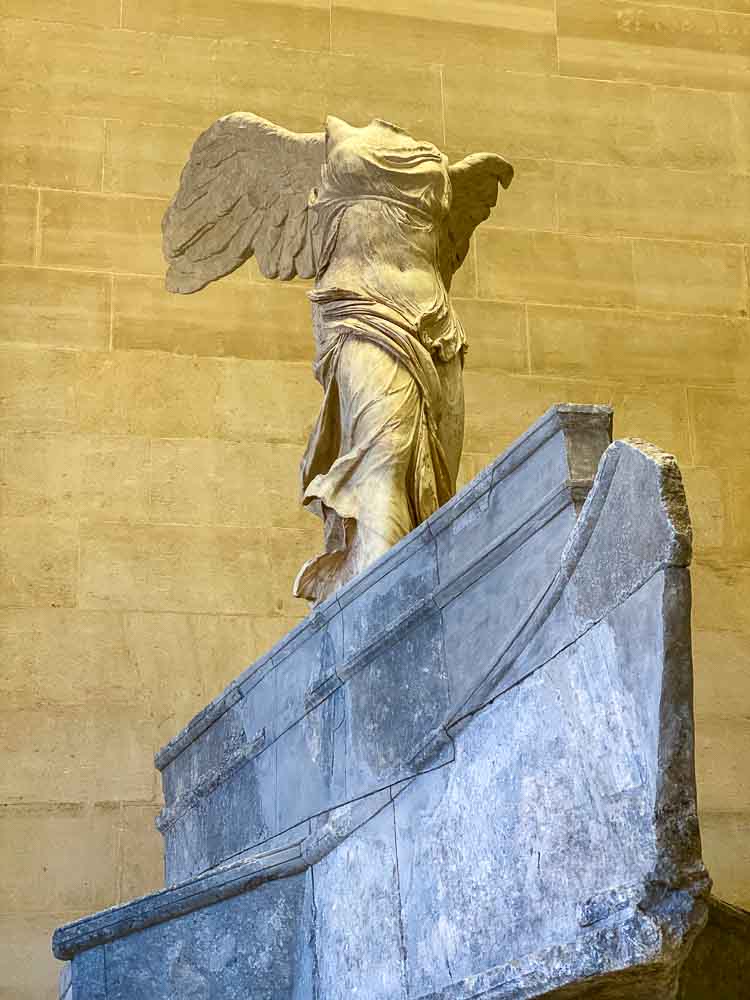

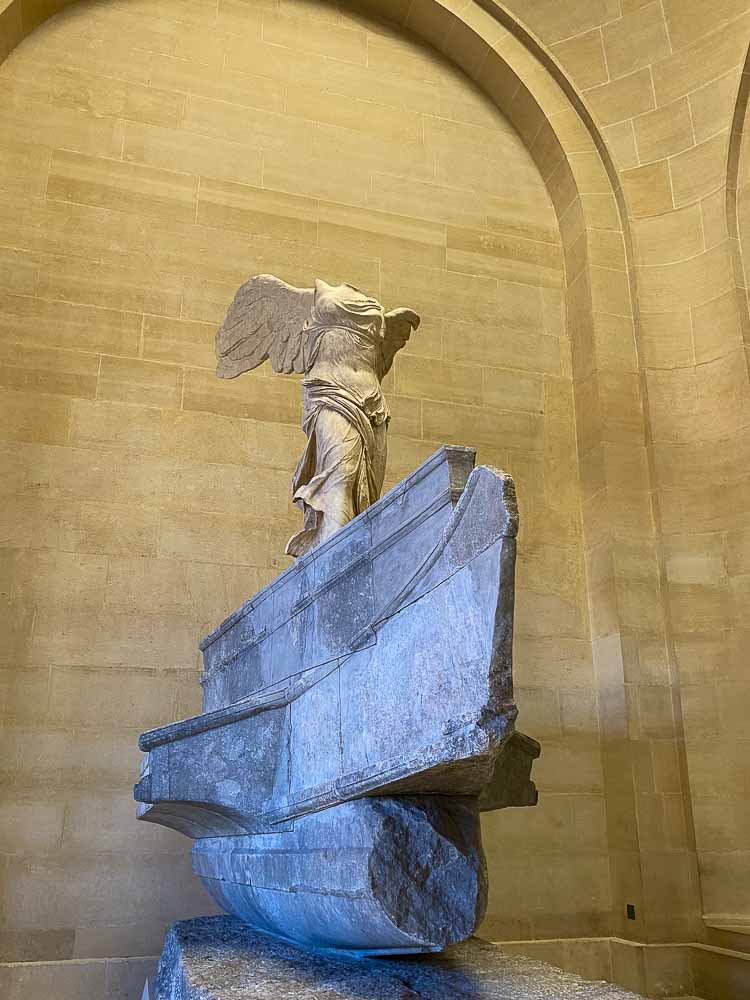
The sculpture depicts Nike as he lands on the bow of a ship after a naval victory. The figure is partially nude, and her robe and hair flutter in the wind.
The Victory of Samothrace is a masterpiece of Greek sculpture and is an impressive example of the skill of Greek artists in creating dynamic and realistic figures. If you are an art lover, you cannot miss this impressive work of art on your visit to the Louvre.
Venus de Milo
If you are looking for a classic masterpiece, you have to see The Venus de Milo. Also known as Aphrodite of Melos, this marble statue represents the Greek goddess of love and beauty.
It was created by Alexandros of Antioch around 150 B.C. and discovered on the island of Melos in 1820.
The Venus de Milo is known for her timeless beauty and elegant pose. Although the statue has lost its arms, its grace and softness remain impressive. The Venus de Milo is one of the most famous works in the Louvre and has been admired by generations of visitors.
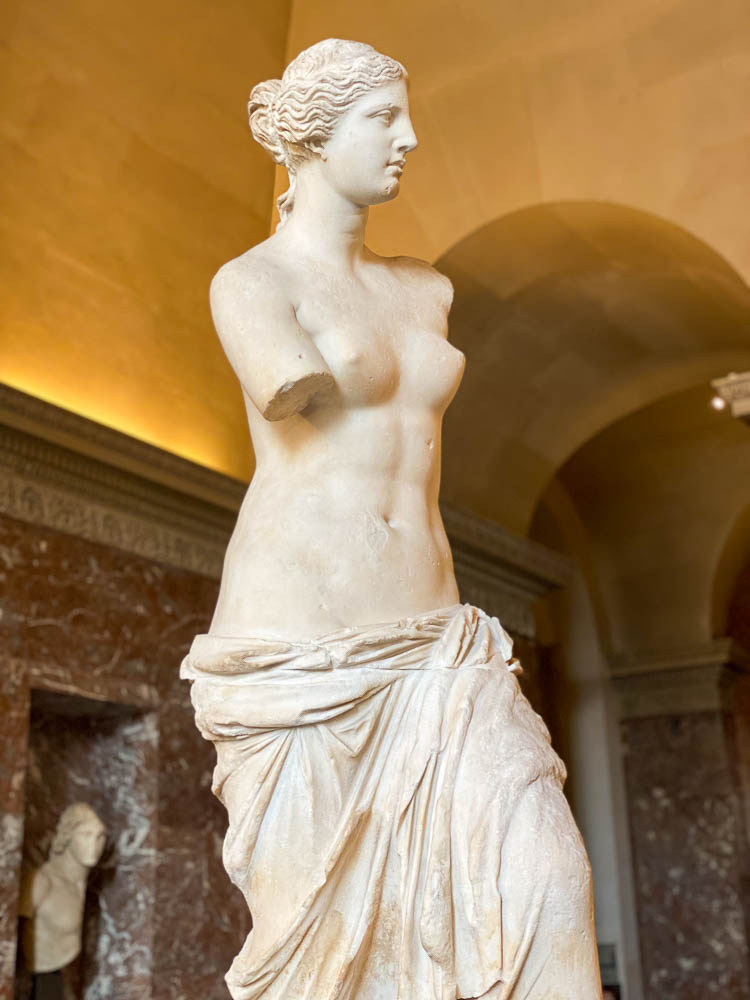
The statue is located in the Gallery of Greek Antiquities, where other masterpieces of ancient Greece are on display. The gallery is an impressive place to explore the rich history of Greek culture and see some of the most beautiful works of art in the world.
If you are interested in the history of the Venus de Milo, be sure to visit the Louvre’s website for more information.
You can also join a guided tour for a more enriching experience and learn more about this masterpiece and other famous works in the museum.
Freedom Leading the People
Liberty Leading the People is one of the Louvre’s most famous masterpieces. This oil painting by Eugène Delacroix depicts a half-naked woman who personifies liberty, holding the French flag and leading a group of people in a fight for freedom during the French Revolution of 1830.
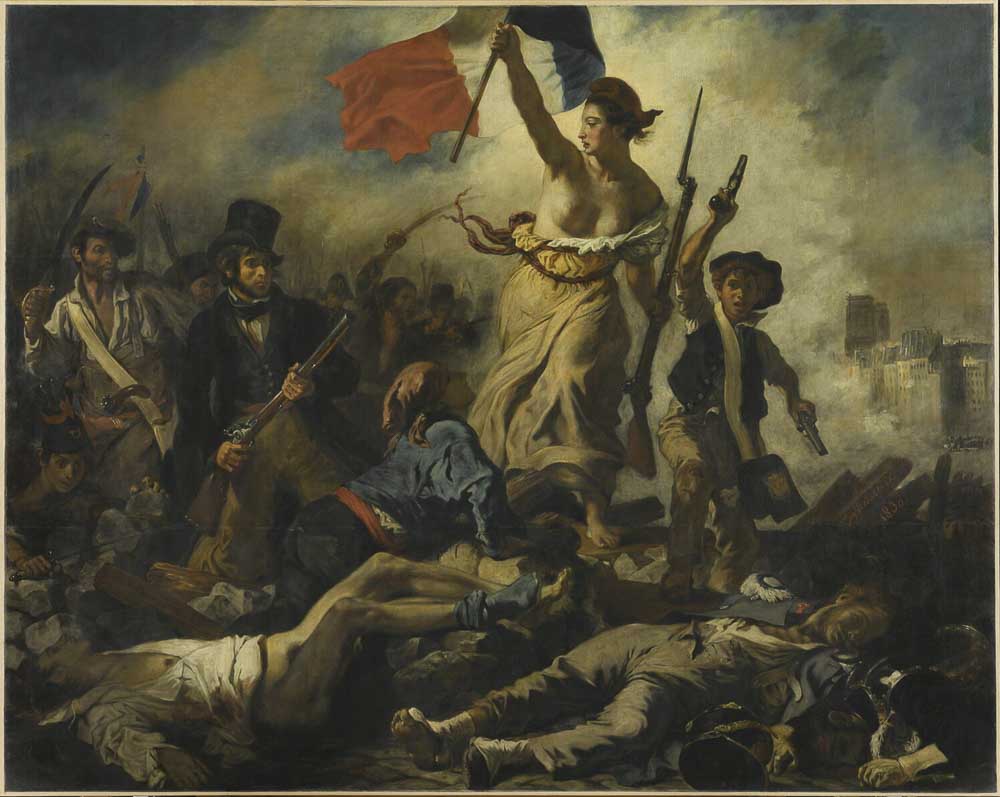
The play is known for its drama and romantic style, and has become a symbol of freedom and revolution in France. The figure of the woman, with her forceful stance and defiant gaze, has inspired many artists and activists over the years.
Liberty Leading the People is in the Louvre’s Mollien Gallery, and is one of the most popular works among visitors. If you plan to visit the Louvre, you can’t miss this masterpiece.
The Coronation of Napoleon
If you love history and art, you can’t miss The Coronation of Napoleon, a masterpiece by French painter Jacques-Louis David.
This painting, housed in the Louvre, is an impressive representation of the coronation of Napoleon Bonaparte at Notre-Dame de Paris in 1804.
The work, which is almost 10 meters wide and more than 6 meters high, is one of the largest paintings in the museum. Watching it, you can feel like you are present at the ceremony, as David manages to capture the majesty and splendor of the event.
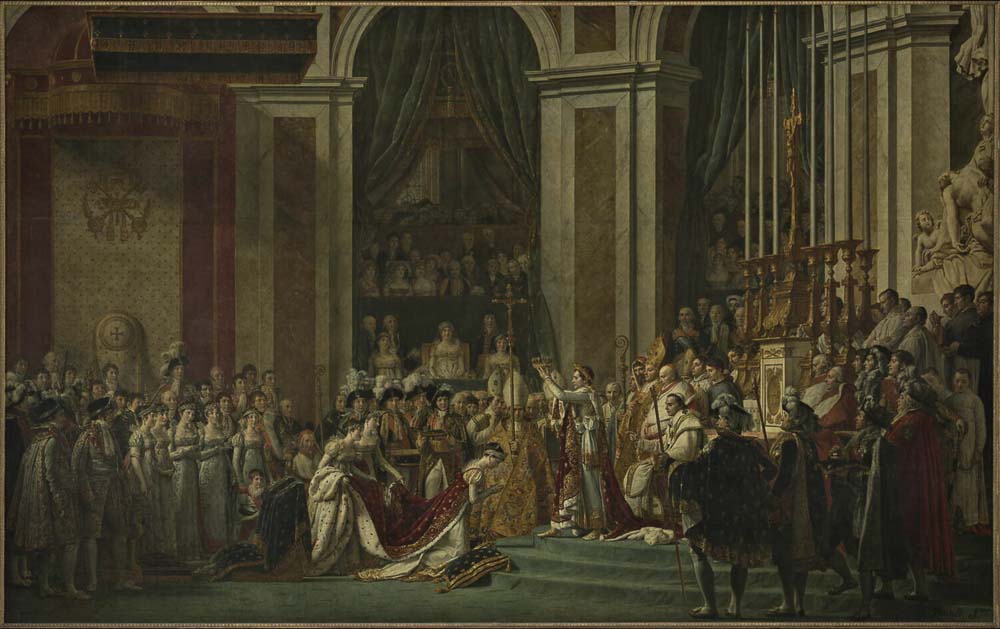
The painting shows Napoleon Bonaparte, surrounded by his family and French high society, as he is crowned Emperor of France by Pope Pius VII. The scene is full of details, from the elaborate costumes to the sacred objects used in the ceremony.
In addition to being an impressive work of art, The Coronation of Napoleon is also an important historical testimony.
The coronation of Napoleon was a key event in the history of France and Europe, and this painting is a faithful representation of what happened on that historic day.
The Raft Of the Medusa by Théodore Géricault
This painting depicts a tragic incident in French history when a ship was wrecked off the coast of Africa in 1816. The survivors of the shipwreck found themselves stranded on a makeshift raft in the ocean for 13 days before being rescued.
The painting is known for its realism and detailed depiction of human bodies and emotions.
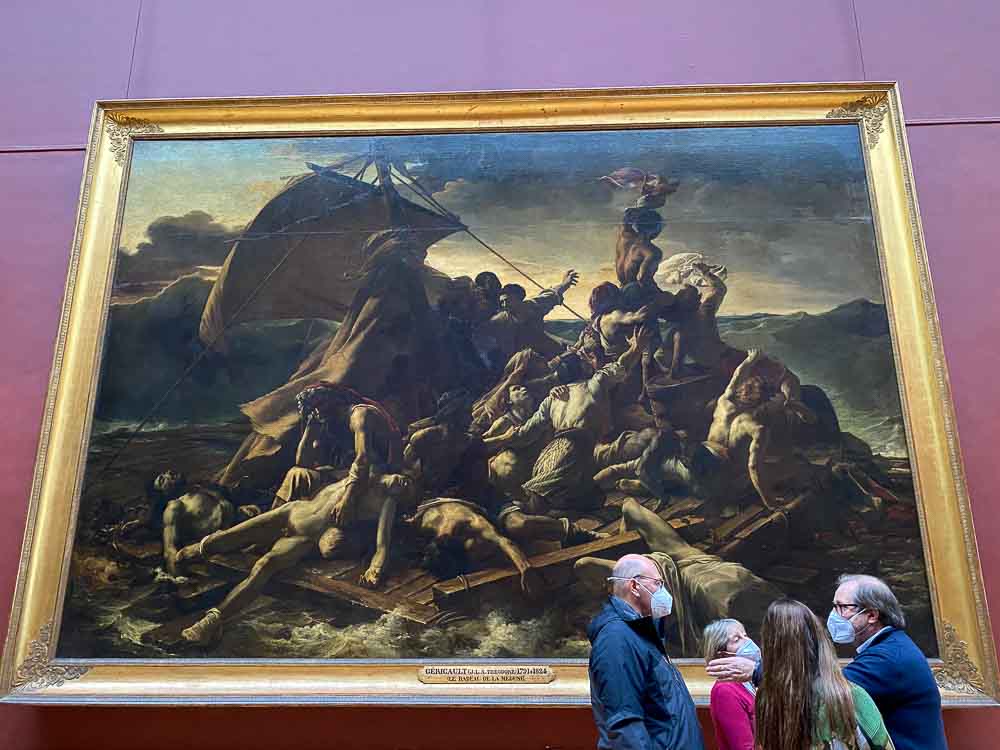
In the Wake Of The Code Of Hammurabi
This carved stone sculpture represents the code of laws of King Hammurabi of Babylon, who ruled more than 3,700 years ago.
The code is one of the earliest known examples of a written legal system and establishes a series of laws and punishments for crimes and disputes.
The stele is known for its historical significance and its detailed cuneiform inscription, which is one of the oldest examples of writing in human history.
Portrait Of Louis XIV by Hyacinthe Rigaud
This portrait depicts French King Louis XIV, also known as the Sun King, who ruled France for 72 years. The painting shows Louis XIV in his royal costume and with the scepter and crown, surrounded by symbols of power and wealth.
The portrait is known for its detail and its depiction of the reign of one of the most famous monarchs in French history.
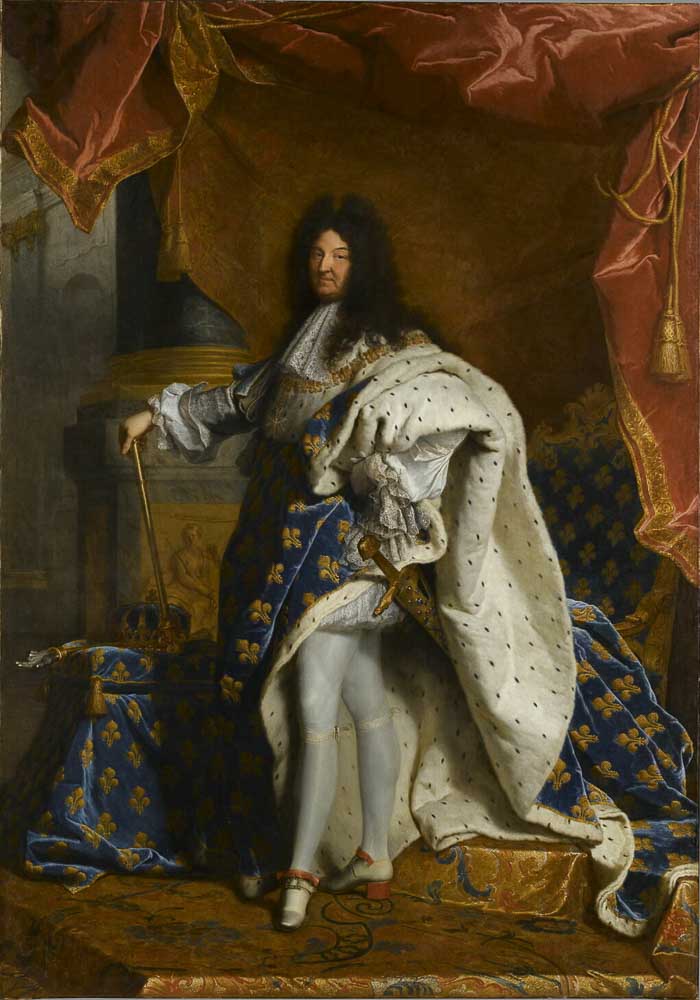
The Sabine Intervention by Jacques-Louis David
This painting depicts an episode from Roman mythology in which the men of Rome kidnap women from the Sabine tribe to increase the population of the city.
The image shows the moment when the women interpose themselves between the Roman men and their Sabine fathers and husbands, thus putting an end to the conflict. The painting is known for its drama and its depiction of female heroism.
The Country Concert (Le Concert Champêtre) by Tiziano
This painting depicts a group of figures in a pastoral landscape, playing and singing music. The characters include two men dressed in the fashion of the period and two nude women.
The painting is known for its beauty and its depiction of nature and music in the Renaissance era.
- Related reading: Museums in the 16th Arrondissement of Paris
Napoleon III Apartments
The Napoléon III Apartments are a series of rooms in the Louvre Museum in Paris, France, that were designed and decorated for the personal use of Emperor Napoleon III and his wife, Empress Eugénie.
The apartments were built in the Richelieu wing of the Louvre between 1852 and 1857, and are located on the second floor of the building.
They were designed by architect Louis Visconti and decorator Charles-Auguste Questel, and feature opulent and elaborate decor reflecting the style of the French Second Empire.
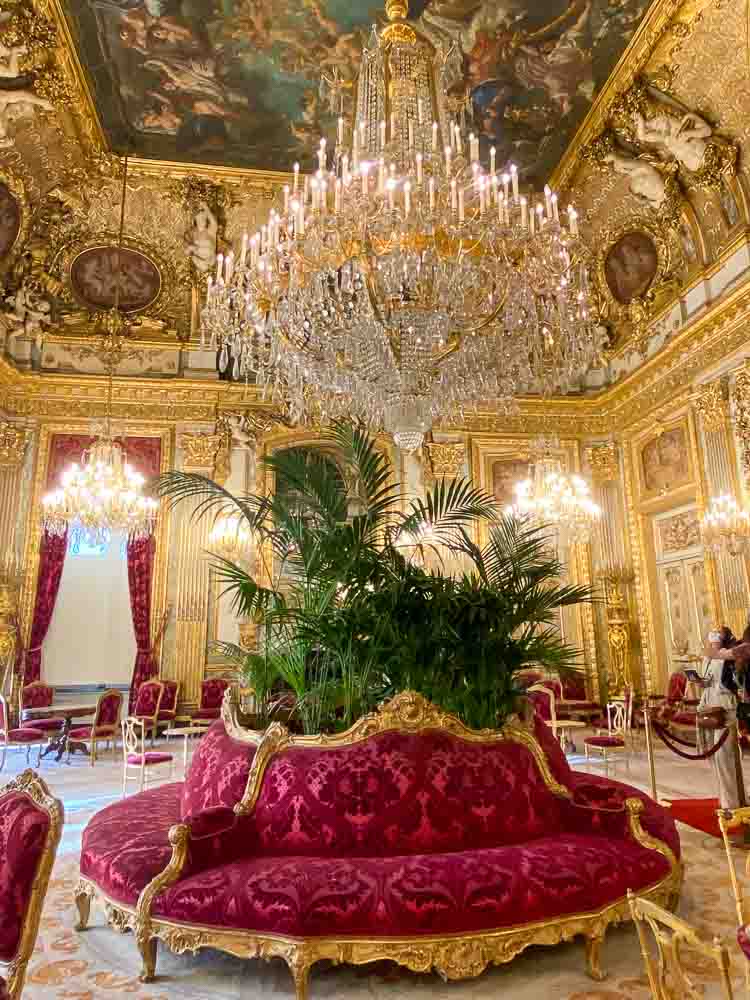
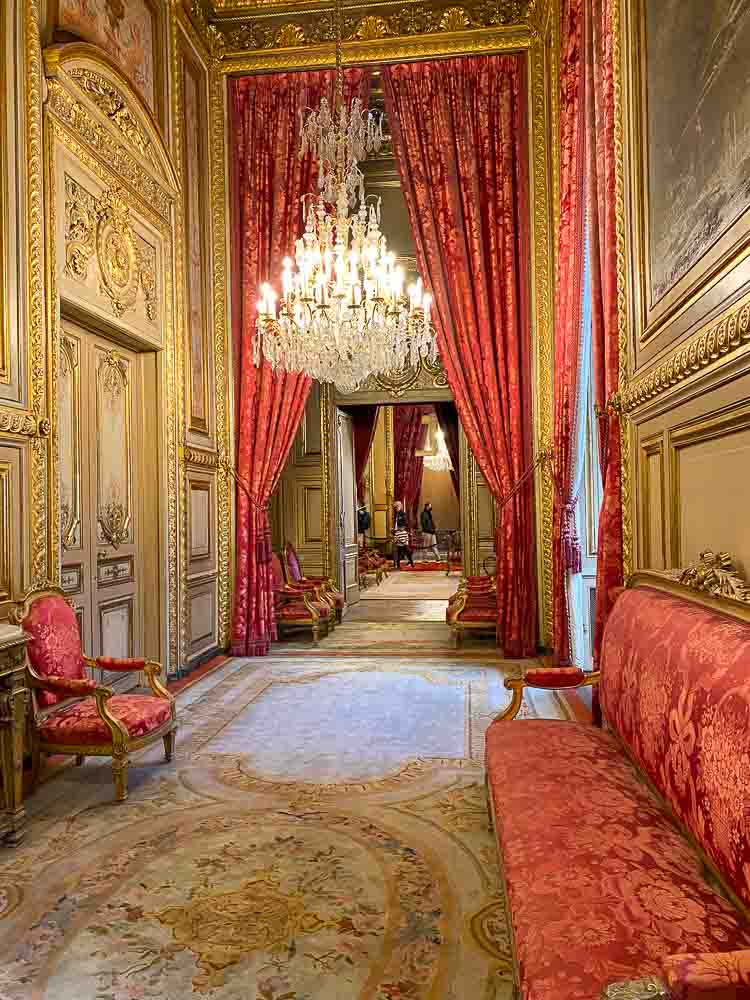
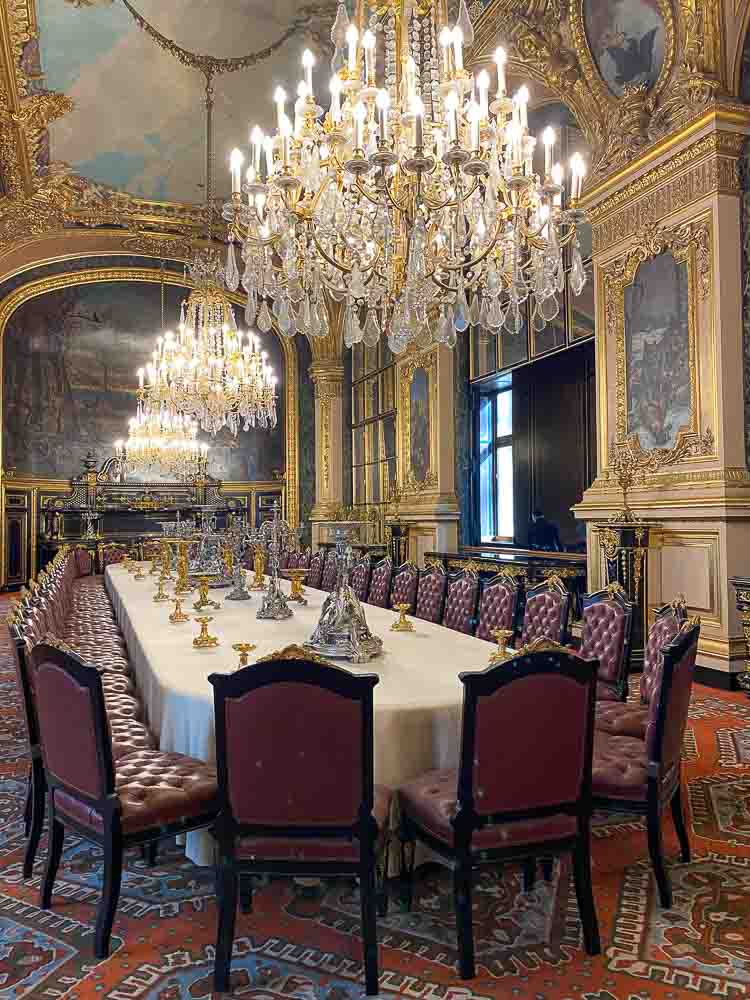
The Napoleon III Apartments consist of five main rooms, each with a different theme and unique decor. These are:
- The Hall of the Nobles: this room was used for official ceremonies and has a luxurious decoration that includes marble statues, velvet curtains and a great deal of gilding.
- The Hall of the Arts: this room is dedicated to the arts and features a collection of paintings, sculptures, and an impressive marble fireplace.
- The War Room: this room has a military theme and is decorated with armor, banners and weapons of the time.
- The Hall of Letters: this room is dedicated to literature and has a library with gilded shelves and antique books.
- The Throne Room: this is the largest room in the Napoleon III Apartments and features spectacular decorations including a gilded throne and an impressive painted ceiling.
Departments and Collections Of the Louvre Museum
The Collection of Egyptian Antiquities is one of the most popular, where you can see mummies, sarcophagi and funerary objects.
Medieval Art and Artifacts are another interesting collection depicting life in the Middle Ages, including manuscripts, jewelry and armor.
The Apollo Gallery exhibits the Crown Jewels and Decorative Arts, which are impressive and dazzling.
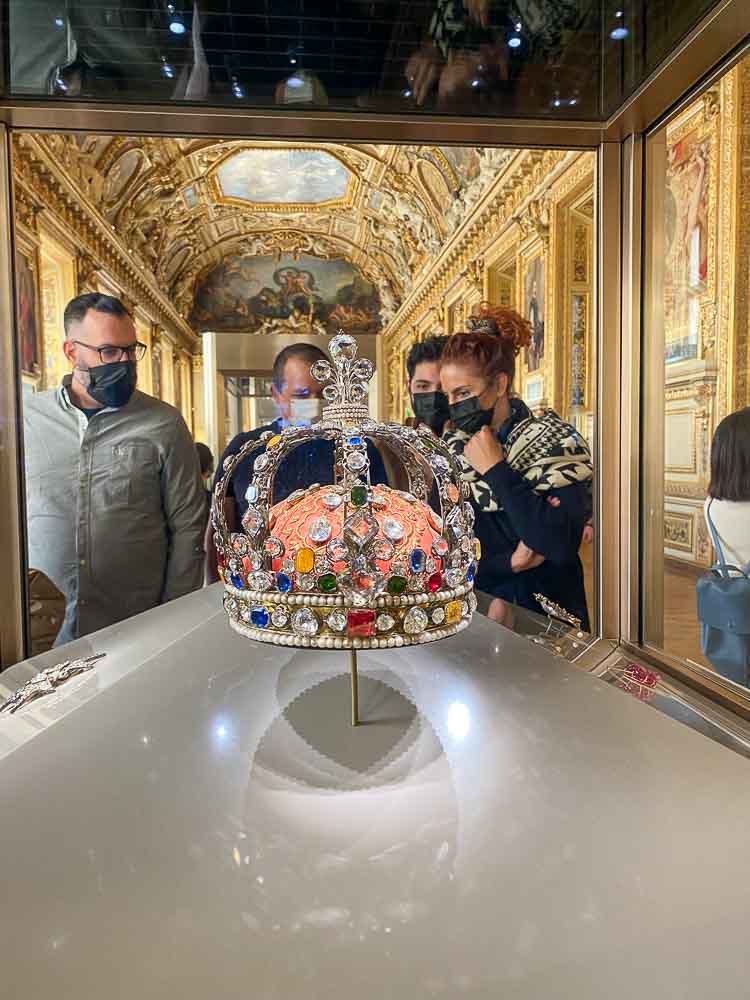
The Louvre Museum’s Paintings Department is one of the largest in the world, with works of art by some of the most famous artists in history, such as Leonardo da Vinci, Rembrandt and Van Gogh.
The Collection of Greek, Etruscan and Roman Antiquities is another not to be missed. Here you can find classical sculptures, vases and mosaics.
The Department of Near Eastern Antiquities is an impressive collection of artifacts from ancient Mesopotamia, Persia and elsewhere.
Islamic Arts is a unique collection that showcases the beauty and complexity of Islamic art over the centuries.
Last but not least, the Louvre Museum also has a Graphic Arts collection, which includes drawings, engravings and photographs.
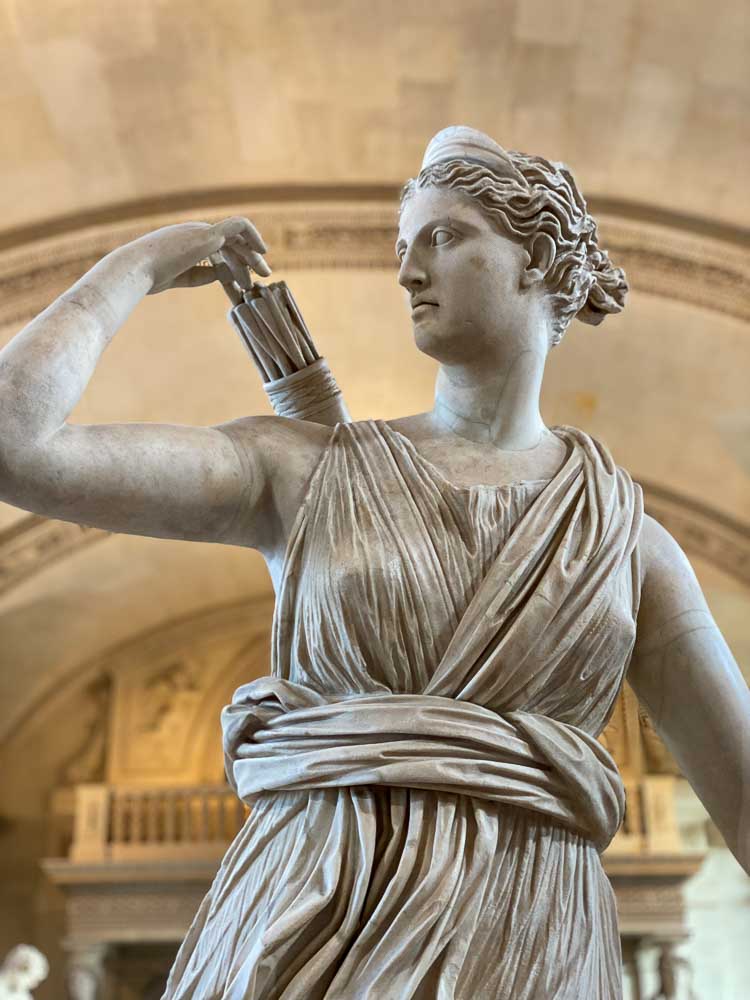
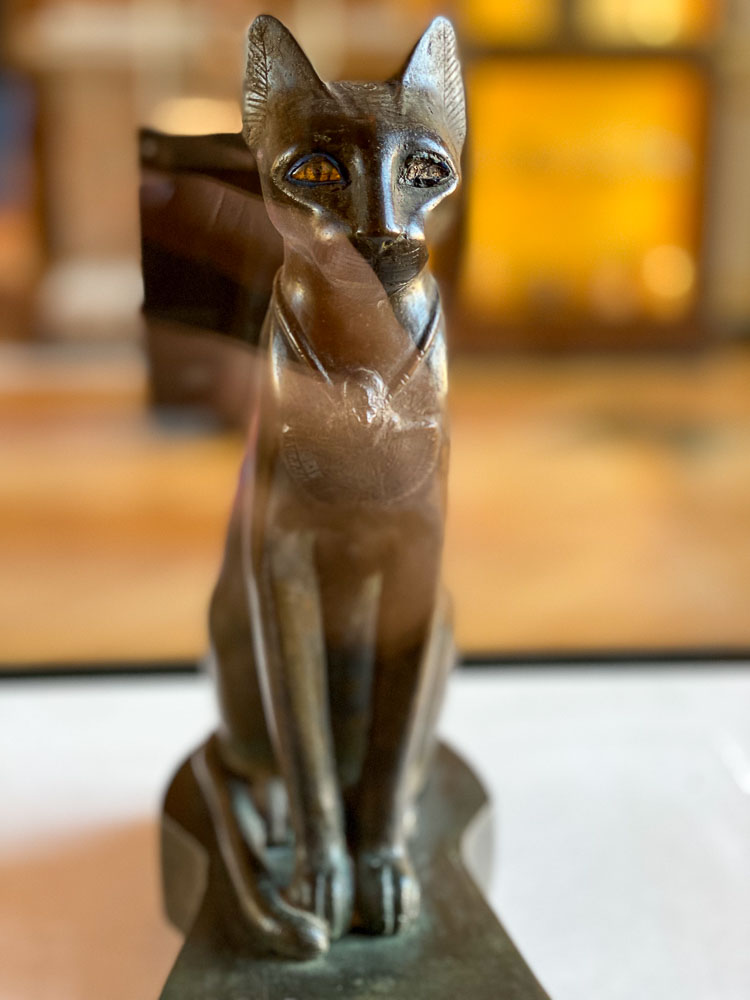
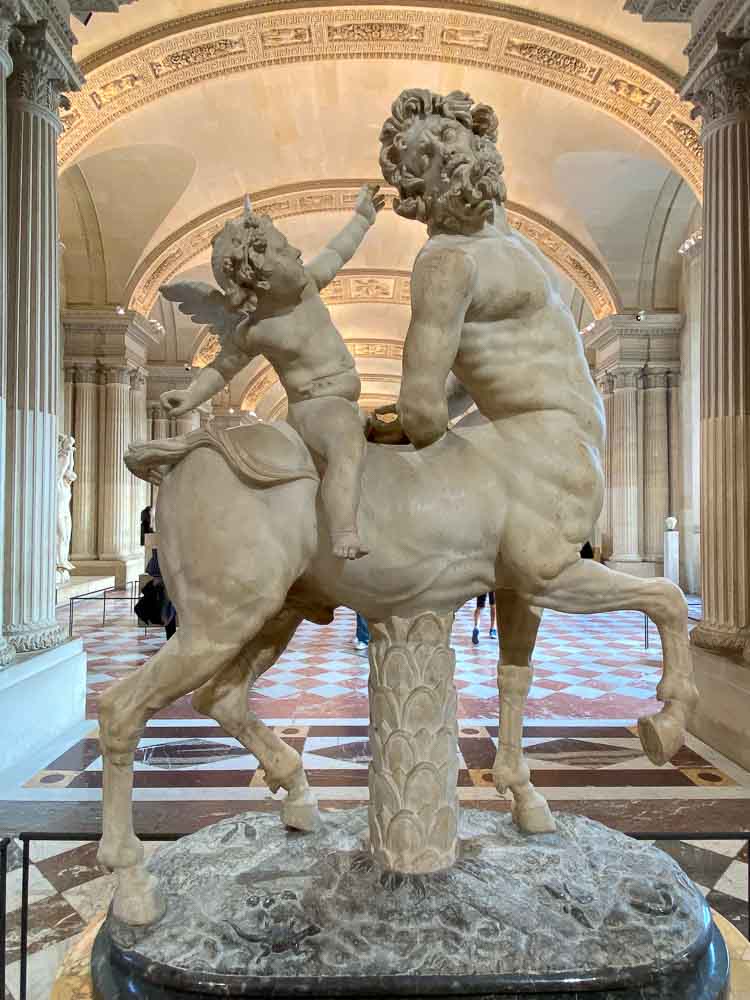
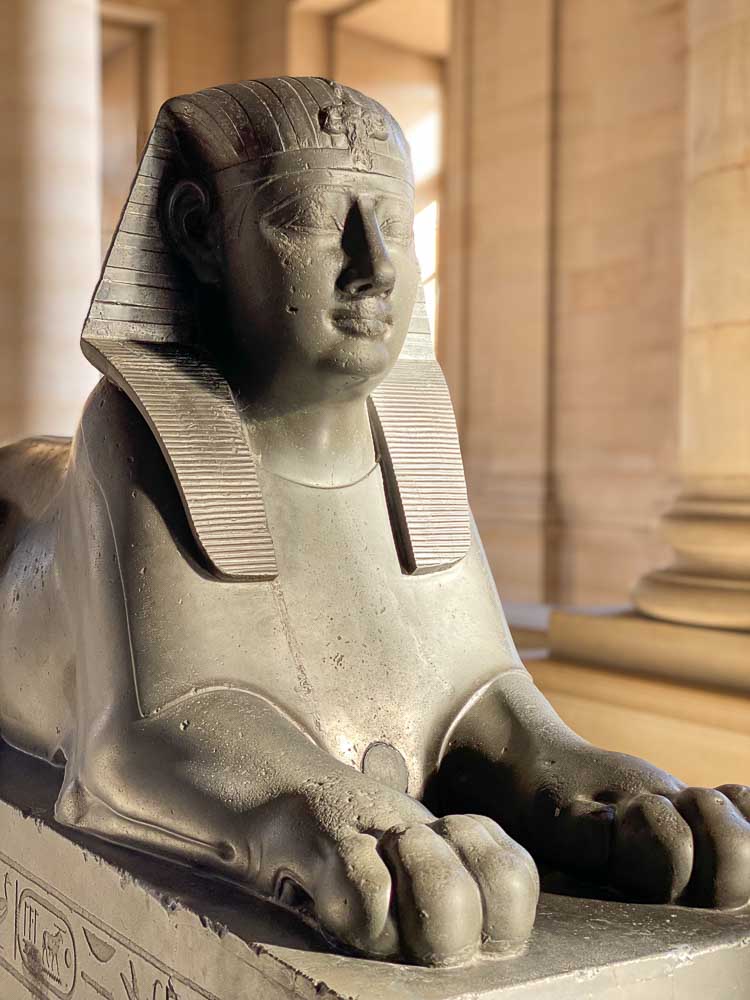
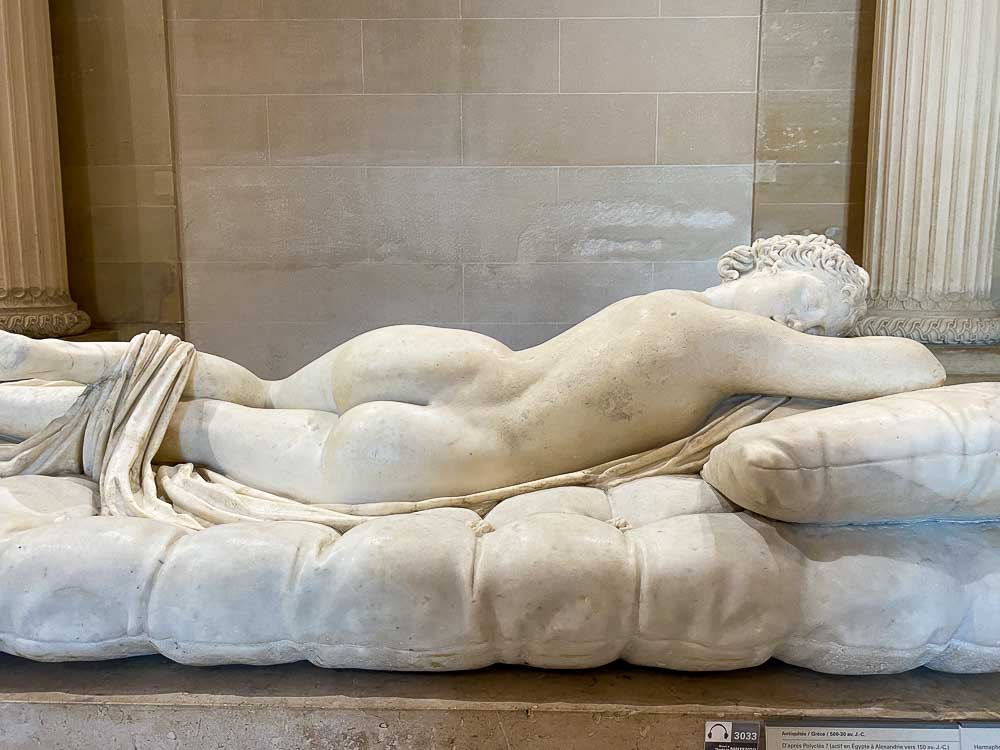
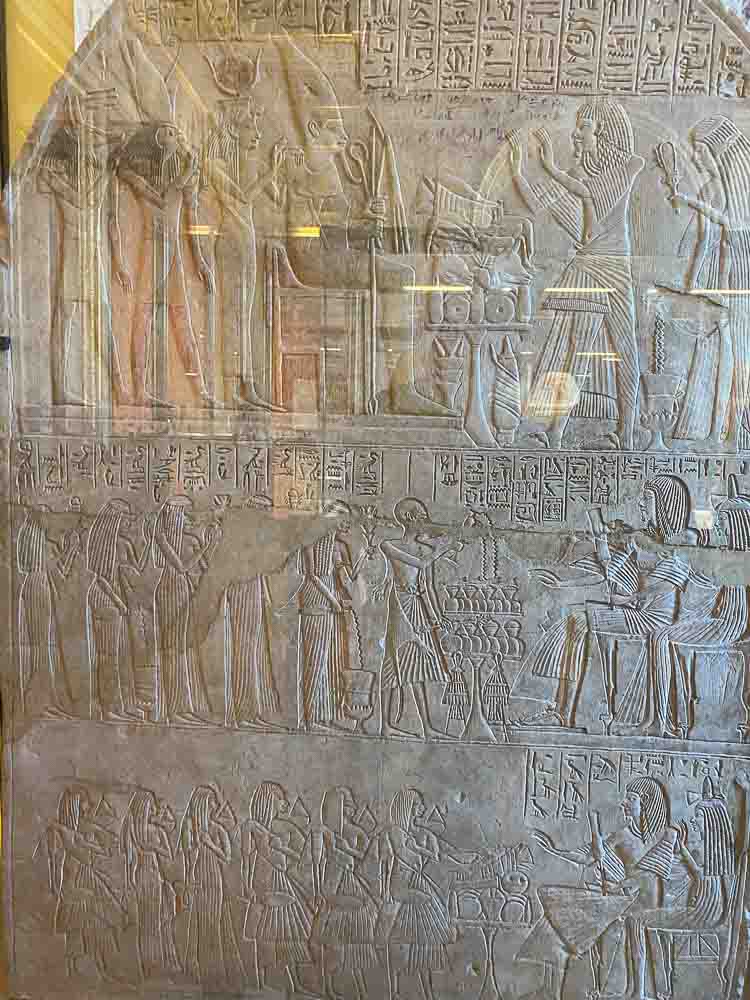
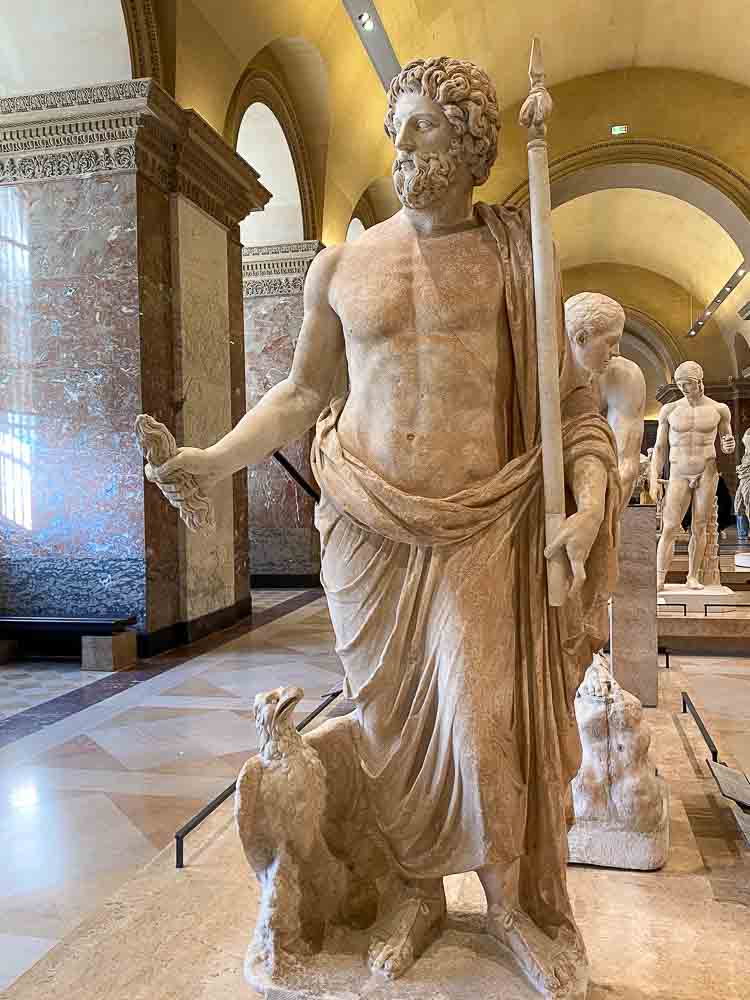
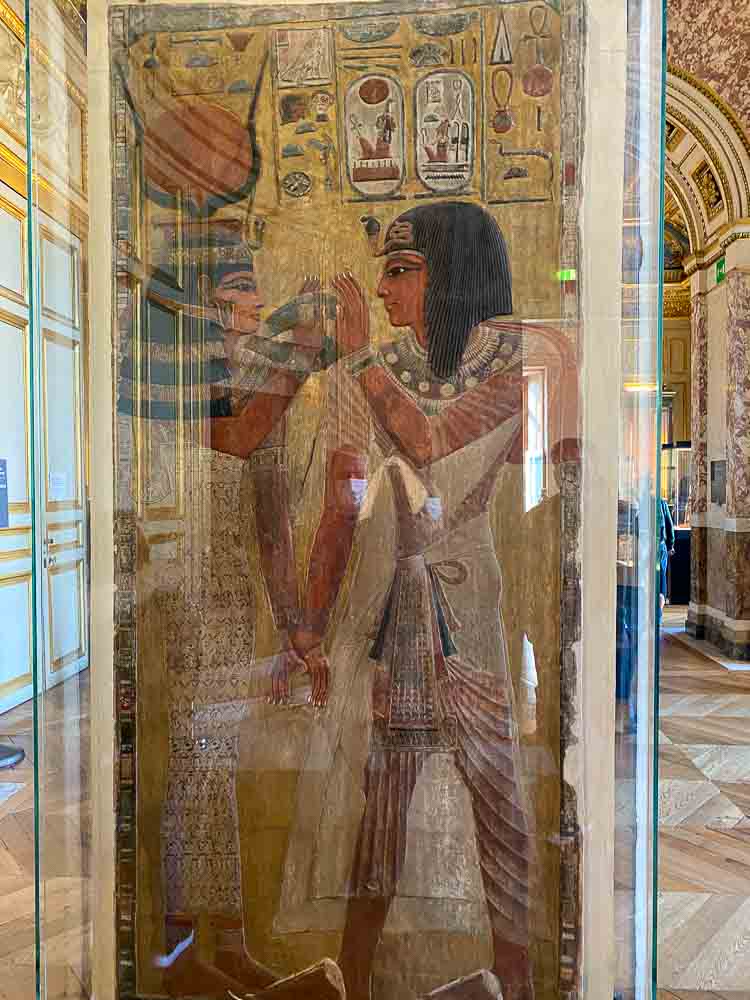
Guided Tours at the Louvre
A guided visit to the Louvre Museum can be a very enriching experience and will allow you to explore the museum in greater depth and knowledge.
Here is a list of some guided tours of the Louvre Museum that you can find online.
Guided tour of the Louvre without queues: This guided tour includes skip-the-line access to the museum and a tour of the museum’s most outstanding works of art, including the Mona Lisa and the Venus de Milo.
Private guided tour of the Louvre: This private guided tour allows you to customize your tour and explore the museum with an expert guide who can tailor the visit to your interests.
Themed guided tour of the Louvre: This guided tour focuses on a specific theme, such as Ancient Greece or the Italian Renaissance, and explores the museum’s works of art related to that theme.
Small group guided tour of the Louvre: This guided tour limits the number of participants to ensure a more personalized and detailed museum experience.
Guided tour of the Louvre by night: This special tour allows you to explore the museum outside normal opening hours and enjoy the works of art in a quieter atmosphere.
Guided tour of the Louvre for children: This guided tour is specifically designed for children and offers a fun and educational experience at the museum.
Is It Possible to Take Photos In the Louvre Museum?
Yes, photography is permitted in most areas of the Louvre Museum, but some important exceptions exist.
For example, areas containing extremely light-sensitive works, such as the Mona Lisa, are strictly forbidden for flash photography, as the light from the flash can damage the painting.
In addition, there are some areas of the museum where photography is completely prohibited, such as in some temporary exhibitions or in certain rooms containing sensitive or delicate objects.
In these cases, a sign is usually posted or the public is warned not to take photographs.
It is important to note that while photography is permitted in most areas of the Louvre, visitors are expected to respect the works of art and other visitors.
Therefore, it is not allowed to use tripods or selfie sticks or block the path of other visitors to take a picture. In addition, it is recommended to turn off the sound of the telephone and not to talk loudly to avoid interrupting other visitors.
- Related: The best Free Walking Tours in Paris
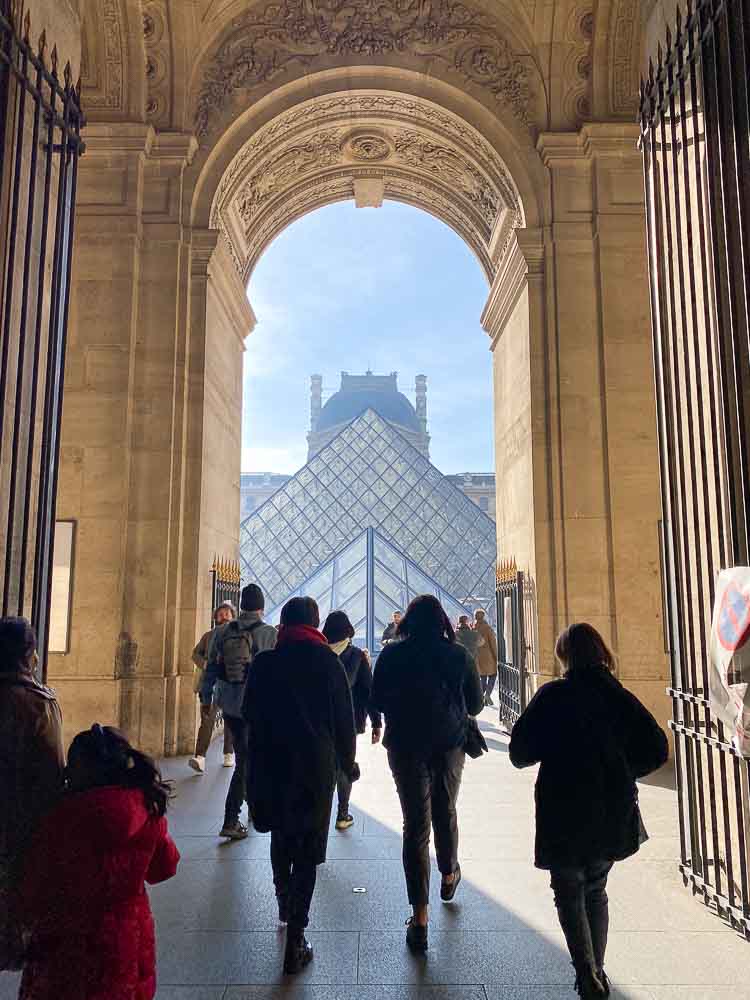
When Is the Best Time to Visit the Louvre Museum?
The Louvre Museum is one of the most popular tourist sites in Paris, which means it can be very busy at certain times of the year and at certain times of the day.
However, there are some tips that can help you avoid crowds and make your visit more enjoyable.
In general, it is recommended to visit the Louvre on weekdays and during off-peak hours. Most visitors arrive at the museum in the mornings and midday, so it may be less crowded in the afternoon.
It is also suggested to avoid visiting the museum on holidays or on days when there are major events or festivals in Paris, as there may be more tourists in the city.
Another option is to purchase tickets in advance or book a guided tour. This can help you avoid lines at the museum entrance and give you a better understanding of the museum’s collection and history.
In addition, on some days the museum is open at night, which may be an option for those who want to avoid crowds during the day.
In summary, the best time to visit the Louvre is on weekdays outside of peak hours, and if possible, buy tickets in advance or book a guided tour to avoid the queues.
- Related reading: Practical tips for traveling to Paris for the first time
How to Get to the Louvre Museum
The Louvre Museum is located in the center of Paris, making it easily accessible by public transportation.
Metro:
The easiest way to get to the Louvre is by metro. The nearest stations are:
- Palais Royal – Musée du Louvre (line 1 and 7)
- Louvre-Rivoli (line 1)
- Tuileries (line 1). All these stations are within walking distance of the museum.

Bus:
The bus is also a convenient option to reach the Louvre. Several bus lines, including lines 21, 24, 27, 39, 48, 68, 69, 72, 81 and 95, stop near the museum.
Cab:
Cabs can also be taken to the Louvre. There is a cab stand just outside the main entrance of the museum.

On foot or by bicycle:
Finally, another option is to walk or bike to the Louvre. The museum is centrally located and easily accessible on foot or by bicycle from many parts of central Paris.
Is it Worth Visiting the Louvre Museum?
Yes, absolutely! The Louvre Museum is definitely a worthwhile visit to Paris. With an unparalleled collection of works of art from around the world, the Louvre is one of the most famous and renowned museums in the world.
The museum houses more than 35,000 works of art, ranging from antiquity to the 19th century, including some of the world’s most famous and recognized works, such as Leonardo da Vinci’s Mona Lisa, the Venus de Milo and the Winged Victory of Samothrace.
In addition, the Louvre building itself is an architectural masterpiece with a long and rich history dating back more than 800 years.
Visitors can explore the ancient foundations of the medieval castle, the 17th-century galleries, the impressive Crystal Pyramid and the extensive museum rooms housing impressive works of art.
Recommendations For Your Visit to the Louvre
Here are some recommendations that may help you to better enjoy your visit to the Louvre Museum:
- Plan your visit: The Louvre is huge and has an enormous amount of art, so it is advisable to plan your visit in advance. Research the works of art that interest you most and make a plan to make sure you don’t miss anything.
- Buy your tickets in advance: Lines to buy tickets can be very long, especially during peak season, so it is advisable to buy your tickets in advance. Online tickets also allow you to skip the lines to enter the museum.
- If you are traveling in high season, book your tickets at least a few days in advance, as they are usually sold out on the same day or the day before.
- Arrive early or late: The Louvre is a very popular place and can be overwhelming at peak times. Try to arrive early in the morning or late in the afternoon to avoid the crowds and enjoy the museum more quietly.
- Use a map: The Louvre is huge and it is easy to get lost. Use a map to help you navigate the museum and make sure you don’t miss anything.
- Dress appropriately: The Louvre is an important cultural institution, so it is important to dress appropriately. Avoid wearing shorts, tank tops and wear comfortable walking and standing shoes.
- Bring a bottle of water: The Louvre is a huge place and walking through the galleries can be exhausting. Bring a bottle of water with you to stay hydrated while exploring the museum.
- Take breaks: Don’t try to see the whole museum in one visit. Take regular breaks and enjoy the museum’s cafes and stores.
- Use the cloakroom service: especially if you are traveling in winter, I recommend that you leave your coat and heavy items in the lockers at the entrance of the Museum. It is the best way to make your visit comfortable.
Conclusion
At the Louvre Museum, you will find world-famous works of art. A visit to this museum will transport you to other times and you will leave amazed and having learned a lot of things.
I hope you enjoy your visit to the Louvre Museum.
Remember, this list is not exhaustive, and there are many other masterpieces in the Louvre that I have not mentioned here. Tell me your favorites in the comments!
Other Information About the Louvre
Why is There a Pyramid in the Louvre Museum?
The glass pyramid was built in 1989 by Chinese-American architect Ieoh Ming Pei as an additional entrance to the museum. It was designed to relieve traffic congestion at the museum’s main entrance and provide a more accessible entrance for visitors.
The glass pyramid is an impressive, modern structure contrasting with the museum’s historic architecture.
It has been criticized by some as an affront to the Louvre’s historical heritage, but it has also been widely praised for its innovative design and its ability to merge the ancient and the modern in a single space.
Today, the glass pyramid is one of the museum’s most famous attractions and has become an iconic symbol of the Louvre and Paris in general.
How Much Money is the Louvre’s Art Collection Worth?
It is difficult to determine the total value of all the works of art in the Louvre Museum, as many of them are priceless due to their antiquity and historical and cultural importance.
The Louvre is the largest museum in the world and houses an impressive collection of some 38,000 art objects, including paintings, sculptures, archaeological artifacts and other objects.
Although there is no exact figure, the total value of the Louvre’s collection is estimated to be several billion euros.
However, for the museum, the value of its collection goes beyond its market price, as many of the works are considered cultural heritage and an integral part of French history and identity.
In addition, the Louvre is a national museum, which means that the works of art it contains belong to the French people and cannot be sold or transferred to private collections.
Instead, the museum focuses on protecting and preserving its collection for future generations to enjoy and learn from.
Plan Your Trip to Paris
- What to wear in Paris according to the season
- The Seasons in France
- Romantic plans for your trip to Paris
- How to get to Versailles from Paris
- Visiting Champagne from Paris
- Visiting the Loire Châteaux from Paris
- How to Get to Giverny from Paris
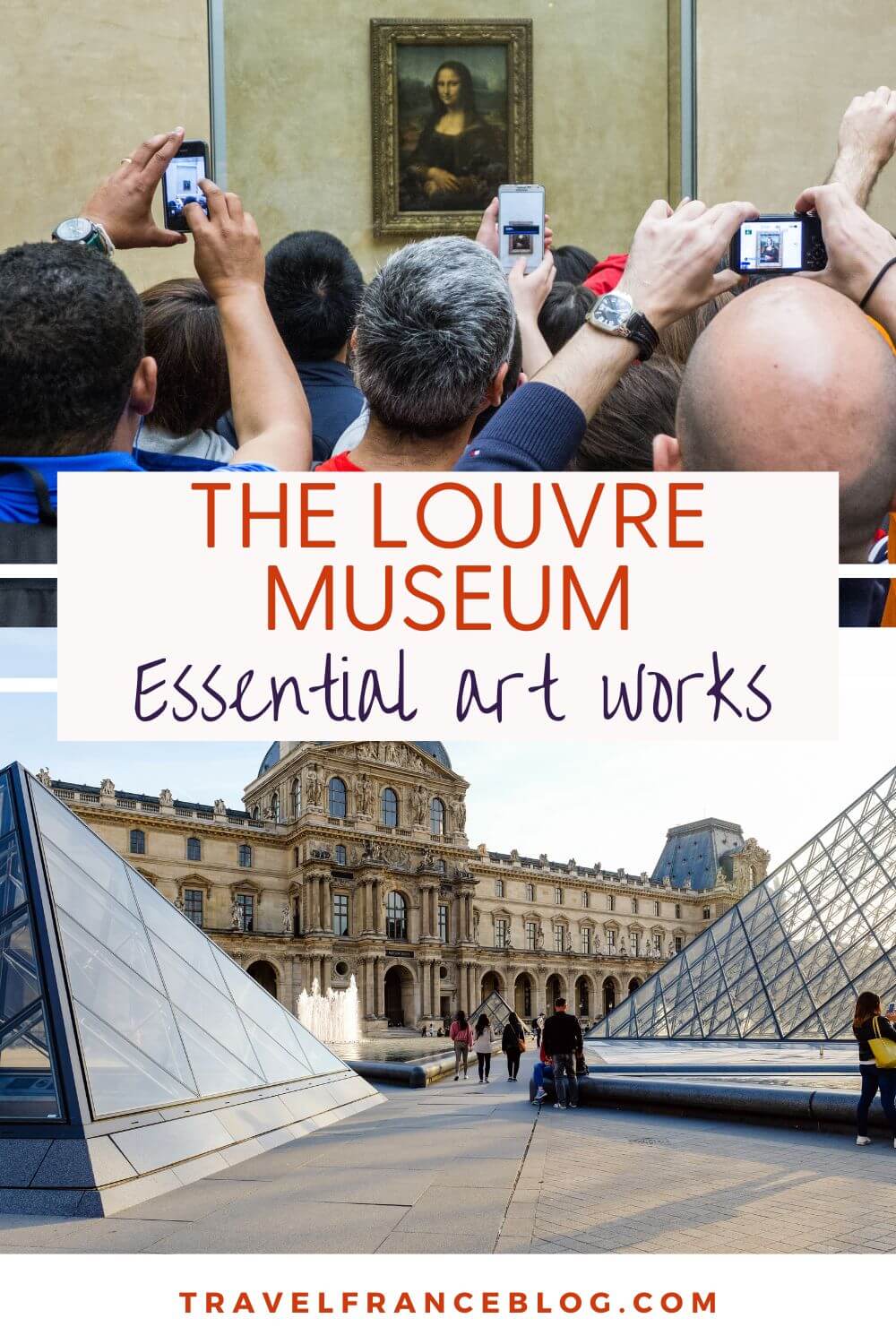
This post may include affiliate links. This means that we will receive a small fee if you make a purchase through our links. It has no additional cost to you. It’s a win-win!



